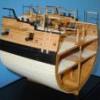-
Posts
2,457 -
Joined
-
Last visited
Content Type
Profiles
Forums
Gallery
Events
Everything posted by dvm27
-

ancre Belle Poule 1765 by j.guydal
dvm27 replied to j.guydal's topic in - Build logs for subjects built 1751 - 1800
Your brass work makes a very convincing substitute for the carvings. Bien fait! -

NRG VIRTUAL WORKSHOP - USING THE TABLE SAW
dvm27 replied to kurtvd19's topic in NAUTICAL RESEARCH GUILD - News & Information
Great workshop Kurt. I also suffered saw-finger once and I'm betting those of us it happened to will never let it happen again. A question regarding the Preac zero-inset with blue tape tip - I'm snow birding so don't have access to my saw but isn't the blade very close to the blade elevating screw? I may be wrong but perhaps this violates the 3" rule? -
I certainly agree with Hakan. Those inset molded details on the bitts and cross pieces are fabulous. Do you use a small chisel, scraper or a combination of both?
-
Thanks, Shipman, for drawing attention to this lovely model. Congratulations to the builder for making a commercial kit into a unique diorama.
- 40 replies
-
- la tartane
- heller
-
(and 1 more)
Tagged with:
-
I agree with Druxey. I have tried ammonia and it did nothing additional but discolor my wood. Currently I use a heat gun (carefully) on wet wood and if you go slowly you can actually feel the lignin fibers relaxing. Also, there is always a degree of spring back so adding an additional 15-20% curve to the formers usually corrects for this.
-
Such a pleasure to see your work in progress. While I included every detail in my Swan class build as well it is a sad fact that most of your current work will not be visible on the finished model, even with partially planked decks. If I had a do-over I would seriously consider adding LED lighting in some of these areas (such as the lanterns in the light room). I know nothing of these things but it seems very doable at your scale.
-
Great gratings Siggi. I learned long ago to make the gratings first to insure full borders on all sides. The coamings and head ledges can always be modified a bit to fit.
-
Well done Rusty, especially when you consider how many variables are involved by the time you get to this area of the ship. That you are so close to spec is a tribute to both your building skills and Chuck's excellent design.
- 642 replies
-
- winchelsea
- Syren Ship Model Company
-
(and 1 more)
Tagged with:
-
Best wishes for a speedy recovery Kevin! Keep away from the sawdust for a few days.
- 1,126 replies
-

USS Delaware 1817 by threebs
dvm27 replied to threebs's topic in - Build logs for subjects built 1801 - 1850
Where do you keep this impressive fleet? This is the kind of collection that museums would hope for. -

Swan-Class Sloop by Stuglo - FINISHED - 1:48
dvm27 replied to stuglo's topic in - Build logs for subjects built 1751 - 1800
Nice job Stu. You might try using Titebond or carpenters glue mixed with black pigment powder. It doesn’t affect the bonding and leaves a nice clean line after sanding. As with all glue I always clean up with water and a small brush after clamping. Much easier to remove while wet.- 475 replies
-

NAIAD 1797 by Bitao - 1:60
dvm27 replied to Bitao's topic in - Build logs for subjects built 1751 - 1800
Best Holiday Wishes for you as well, Bitao, and thank you for sharing your exceptional work with us.! Greg
About us
Modelshipworld - Advancing Ship Modeling through Research
SSL Secured
Your security is important for us so this Website is SSL-Secured
NRG Mailing Address
Nautical Research Guild
237 South Lincoln Street
Westmont IL, 60559-1917
Model Ship World ® and the MSW logo are Registered Trademarks, and belong to the Nautical Research Guild (United States Patent and Trademark Office: No. 6,929,264 & No. 6,929,274, registered Dec. 20, 2022)
Helpful Links
About the NRG
If you enjoy building ship models that are historically accurate as well as beautiful, then The Nautical Research Guild (NRG) is just right for you.
The Guild is a non-profit educational organization whose mission is to “Advance Ship Modeling Through Research”. We provide support to our members in their efforts to raise the quality of their model ships.
The Nautical Research Guild has published our world-renowned quarterly magazine, The Nautical Research Journal, since 1955. The pages of the Journal are full of articles by accomplished ship modelers who show you how they create those exquisite details on their models, and by maritime historians who show you the correct details to build. The Journal is available in both print and digital editions. Go to the NRG web site (www.thenrg.org) to download a complimentary digital copy of the Journal. The NRG also publishes plan sets, books and compilations of back issues of the Journal and the former Ships in Scale and Model Ship Builder magazines.



